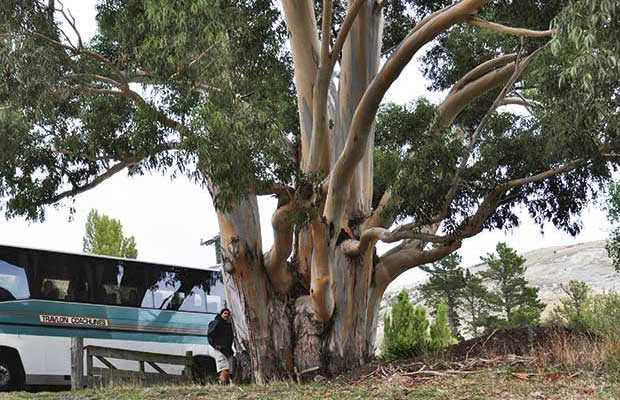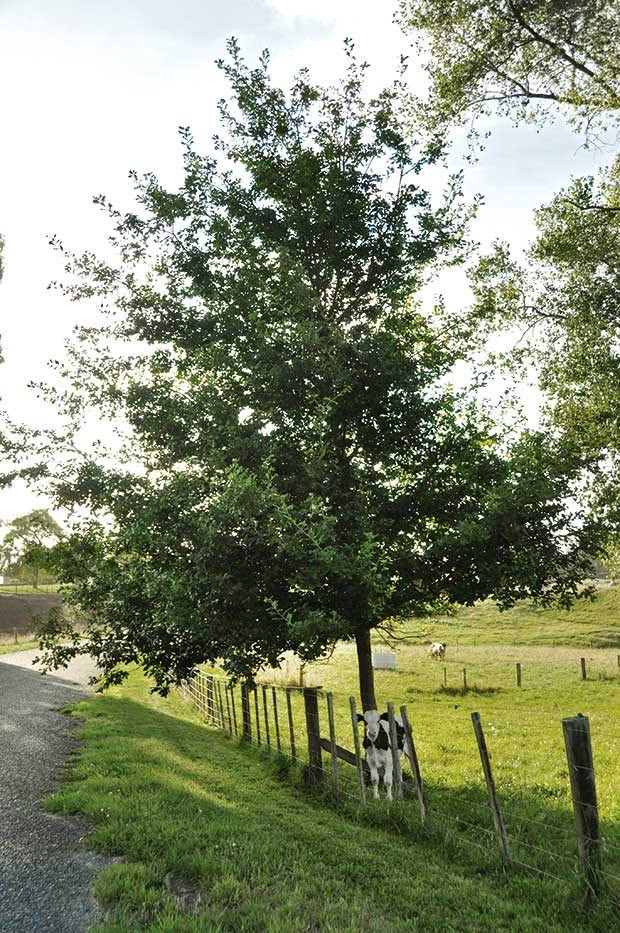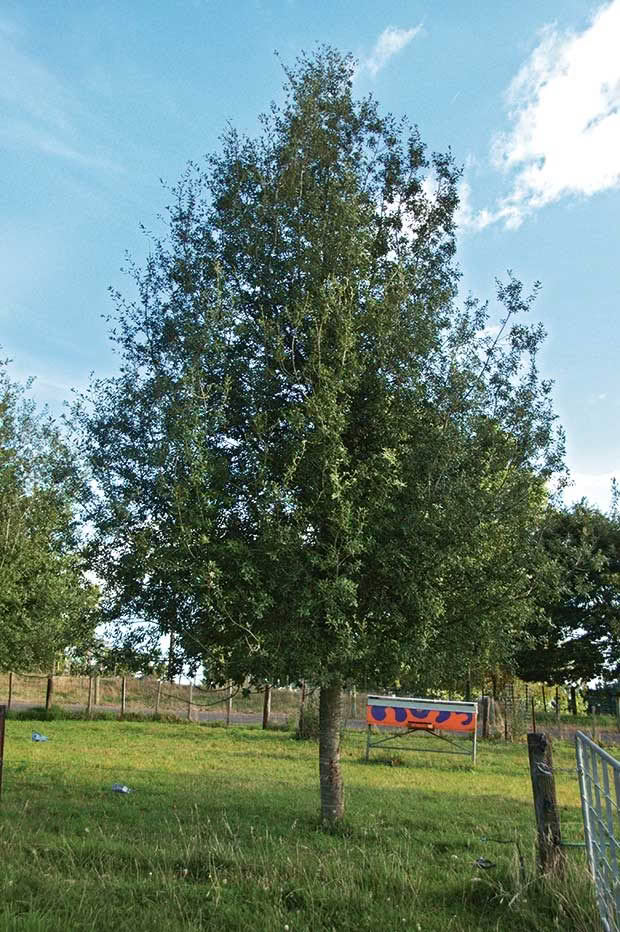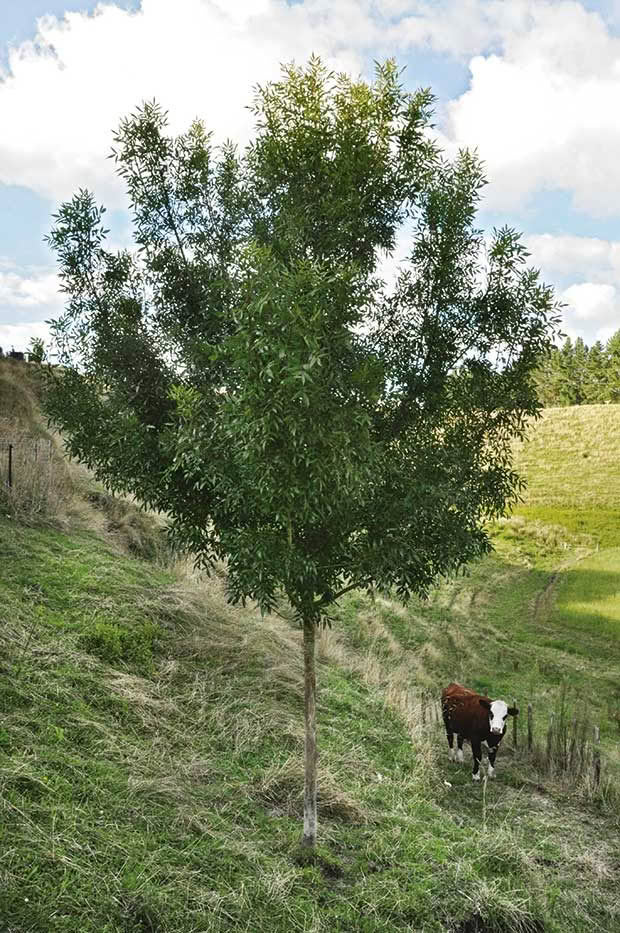10 great trees for a multipurpose woodlot

A good woodlot is for generations to come, so think about harvesting while you’re planting.
Words: Sheryn Dean
I have been a member of the NZ Tree Crops Association for many years now. There are many great reasons to join, but the best is because you get to meet experienced members who are a source of invaluable advice, even if some of it is conflicting!
These are the recommendations I have taken on board regarding firewood.
1. The winner: oak
Oak trees, most varieties, but particularly Quercus rubra (red oak, lovely autumn colour), Q. ellipsoidallis (northern pin oak, very hardy) and common English oak (Q. robur). They are unanimously rated as the best firewood trees for NZ.

English oak.
European farmers have favoured oak for centuries for good reasons:
• its timber is strong;
• ripened acorns of certain varieties feed ducks and pigs, but note green acorns are a common source of toxicity in livestock like cattle and sheep;
• its leaves are good cattle food;
• you can get them inoculated with
truffles to produce a root crop (if conditions are right);
• they can be coppiced and harvested indefinitely
• they result in superior firewood.

Holm oak.
In New Zealand an oak tree grows relatively quickly and can be ready for firewood in just 10 years. It splits well, burns very hot, smells fragrant and doesn’t spark.
2. European ash
Ash is hailed as the firewood of queens. Fraxinus excelsior is rapid-growing, cold-hardy and likes moist sites.
Its main attribute is its low moisture content, burning when almost green which means it can be cut late in the season if firewood supplies look inadequate. It also splits well, doesn’t spark, burns hot and produces very little smoke.
If coppiced in late winter, the stump will stay dormant until the following spring. It may look dead but be patient.
Ash wood is highly prized. It is the only wood to consider if you want to make your own softball bats or axe handles, arrows or hurley sticks (an ancient Irish hockey-type game) if you need them.

Ash.
Ash ‘keys’ (its seed) can be pickled and eaten, the leaves and bark are used in modern medicine, and all are good stock food.
3. Alder
As firewoods go, alder only rates as good instead of excellent. It has a straight grain that is easy to split and will dry quickly, but it is not as hot burning as oak and ash and will give the occasionally spark.
However, it’s included in this list because it is a nitrogen-fixing tree that will substantially enhance the growth of others, and it is very wind hardy, making it worth mixing into the windward side of your woodlot.
It won’t coppice, but is very quick- growing. Alder are wind-pollinated, and the pollen makes great early spring food for bees to feed their babies.

Alders.
Alnus cordata, the Italian alder, excels in South Island climates, A. rubra (red alder) has good autumn colour, and A. glutinosa (black alder) does well too. They like moist sites but can send seed downstream to become a nuisance if planted by running water.
4. Maple
The sugar maple (Acer saccharum) is the USA’s favourite firewood. It burns as hot as oak, doesn’t spark and has little smoke, but it doesn’t have the straight grain which makes splitting into kindling easy.
As a tree it is quite cold-hardy, but it needs fertile soils to grow quickly. It has beautiful autumn colour. If you are so inclined and conditions are right, you can always tap the sap for maple syrup.
Wilted leaves are apparently toxic to horses.
5. Hickory
Hickory wood is heavy, difficult to split and sparks a little, but it burns exceedingly well, hotter even than oak and sugar maple. It also emits a fragrant smoke that is used to smoke food (although in my opinion, fruit woods are better).
In New Zealand only Carya laciniosa is fast enough growing to consider including in a firewood lot. It likes moist, rich soil. If grown from seed, it will grow slowly for a couple of years while it establishes a deep root, then suddenly put on good growth.
It has the largest of the hickory nuts, (hickory are in the same family as pecans and walnuts) which are sweet and quite edible for humans or animals.
The wood is good for furniture, tool handles and – if you need them – drumsticks.
6. Fruit woods
Apples, pears, plums, apricots, peaches and cherries all make good firewood. They are reasonably dense, fairly easy to split and burn, throw few sparks and have fragrant soft smoke.
Most are harvestable size in 10 years, and while they are growing, they are providing food for you and/or your stock.
All can be grown from seed. Stonefruit will grow pretty much true to the parent so if you eat a nice fruit, pop the stone in the ground.
With pipfruit, it’s a lottery. You really won’t know how good it is until it fruits, but the bonus is if it’s no good, it’s firewood.
Japanese plums grow bigger and quicker than the English plums. Pears can get huge with age.
7. Acacia/wattles
Most acacia make good firewood. Blackwood (Acacia melanoxylon) is the most common in New Zealand and grows into a quality timber.
It is known for its ease to coppice, reshooting after cutting so well that some in the Waikato consider it a weed. However, if managed properly, with suckers regularly thinned, it can be a perpetual source of good firewood.
A. delbata, (silver wattle) is an ornamental tree with bright yellow flowers in winter. It is quick growing but can blow over on windy sites.
A. mearnsii (black wattle)is so fast-growing it is considered one of the worst invasive species of the world. However, it has a very nitrogen-rich pollen with no nectar – I have heard these trees humming in winter with bees – and all wattles are nitrogen-fixing, converting nitrogen from the air into the soil for other plants to use.
8. Robinia
Robinia pseudoacacia, also known as black locust, is highly valued as a firewood. It burns slowly with little visible flame or smoke, it has a heat output similar to quality coal, and makes good embers. The wood will burn when green, although it is better when dried.
Young, straight-grained wood rarely sparks, but knots and insect damage can cause it to spit coals. The timber is very hard and durable – you can peel off the bark to make your own posts.
It will coppice easily, the flowers are excellent bee food (it’s a major honey plant in the eastern US) and the plant fixes nitrogen into the soil.
It will grow in poor soils where its shallow roots are good for erosion control.
9. NZ natives
Natives don’t grow fast enough to consider planting for firewood. However, if you are (legally and sustainably) cutting some down, they are worth adding to your firewood pile.
Native beech is an excellent firewood that burns hot and long and will – if you are caught in the bush and need it – burn while still green. It has superior timber value but takes about 20-30 years to grow to size.
Manuka and kanuka are both good firewoods, burning hot and long and slow but are best mixed with a fast-burning wood. The trees don’t grow too big to handle but can take 15-20 years to reach a worthwhile size.
Kauri and totara have a straight grain which makes easy splitting into kindling. Note, kauri means “to burn sootily”. Matai and kowhai are both good firewood, and maire burns so hot it will burn out fireboxes.
10. Gums (with a proviso)
Gums are well-known in NZ as good firewood trees. There is a species for just about every climate and if matched properly, they grow fast and the resulting timber, if dried properly, burns hot and long.
But their speed of growth means they get pretty big, pretty quick and while this may sound like a good thing when you don’t have any firewood now, it is a mission to deal with in 20 year’s time when you are trying to manage a chainsaw and your walker.
My advice? If you do plant gums, cut them at about five years old and don’t let them get away on you. Gums are not useful for much else and older trees can drop large branches damaging fences and buildings – they are known as ‘widow makers’ in their native Australia because so many people die while taking shelter under them during storms.
Warning: their roots can extend out up to 30m, upsetting driveways and drains, and sucking nutrients out of the ground to the detriment of grass or other trees.
Love this story? Subscribe now!
 This article first appeared in NZ Lifestyle Block Magazine.
This article first appeared in NZ Lifestyle Block Magazine.
